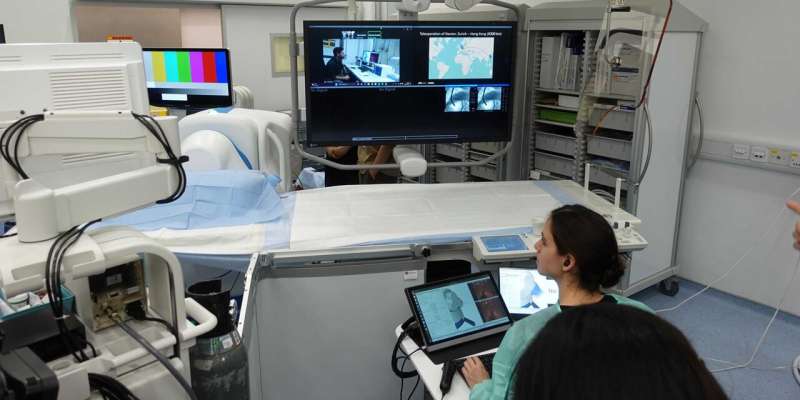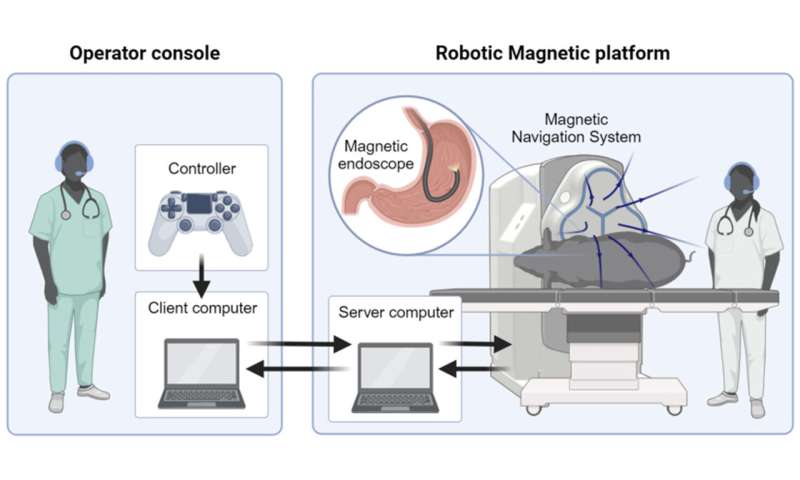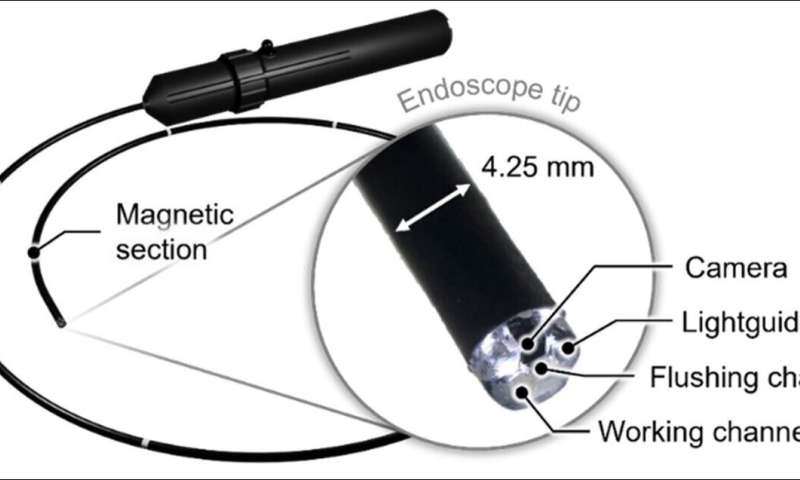This article has been reviewed according to Science X's editorial process and policies. Editors have highlighted the following attributes while ensuring the content's credibility:
fact-checked
trusted source
proofread
Researchers in Zurich successfully perform remote magnetic endoscopy on a live pig in Hong Kong

Researchers at ETH Zurich and The Chinese University of Hong Kong have succeeded for the first time in using remote control to perform a magnetic endoscopy on a live pig. The researchers controlled the probe from Zurich while the animal was on the operating table in Hong Kong.
It's three o'clock in the morning, and Alexandre Mesot is in a room in Zurich operating an endoscope. The doctoral student in ETH's Multi-Scale Robotics Lab, headed by Professor Bradley Nelson, looks at a screen displaying live images of the endoscopy as he manipulates the joystick of a PlayStation controller. The operating theater, however, is in Hong Kong—more than 9,300 kilometers away.
With a delay of only around 300 milliseconds, a 4-millimeter-thick probe responds to the signals from Zurich as it moves around the stomach of a live (anesthetized) pig in the operating theater in Hong Kong. Mesot guides a camera to examine the animal's stomach wall and takes tissue samples with a tiny gripper arm.
This procedure is the first ever remote-controlled magnetic endoscopy. Details have just been published in the journal Advanced Intelligent Systems.
Two things were crucial for this breakthrough: a magnetic navigation system developed at ETH Zurich with a magnetically operated endoscope, and a secure, fast internet connection to the operating theater.
Safety first
In the operating theater, the remote-controlled procedure was supported and monitored by surgeons from the Faculty of Medicine at The Chinese University of Hong Kong. Before Mesot took over the navigation of the probe in Zurich, it was tested in the operating theater by a team from the Multi-Scale Robotics Lab and by the Hong Kong surgeons. The latter also inserted the magnetic endoscope through the pig's mouth into its stomach.
The endoscope is controlled by a magnetic field generated by Navion, a surgical navigation system that ETH Professor Nelson and his team developed. "Not only can the endoscope be bent in any direction thanks to its magnetic head; it's also smaller and easier to maneuver than conventional devices," Mesot explains.
Magnetic endoscopies are less stressful
Thanks to the superb flexibility of the magnetic endoscope, Mesot was able to carry out a maneuver called a retroflexion in the animal's stomach without any problems: after entering the stomach cavity, the endoscope is bent backwards 180 degrees to inspect the stomach's entrance. This complex procedure shows that magnetic endoscopes can be manipulated remotely at least as flexibly as standard devices.
In addition, the smaller endoscope can also be inserted via the nose in humans rather than via the esophagus, as is usual with conventional endoscopies. This is less stressful, as patients don't have to be fully sedated and can stay awake during the procedure to provide feedback. The magnetic endoscope is also potentially suitable for use in children, for whom the usual probes are too large.
-

This illustration shows how a remote-controlled endoscopy works. Credit: Advanced Intelligent Systems (2024). DOI: 10.1002/aisy.202400522 -

A magnetic head makes the endoscope particularly manoeuvrable. Credit: Advanced Intelligent Systems (2024). DOI: 10.1002/aisy.202400522
Minimally invasive cancer screening and better care in remote areas
Professor Nelson from the Multi-Scale Robotics Lab at ETH Zurich is already thinking ahead. "In the next step of our research, we hope to carry out a teleoperated endoscopy on a human stomach. There's a lot of potential in this technology. Here I'm thinking of minimally invasive procedures in the gastrointestinal tract, such as cancer screening."
Dr. Shannon Melissa Chan, Assistant Professor in the Faculty of Medicine at The Chinese University of Hong Kong, also points out, "Teleoperated endoscopy can be used not only for training surgeons, but also for providing diagnostic and surgical care in remote areas, especially in places where there's a lack of local expertise. We could even provide trained nurses with instructions from a distance on how to carry out the procedures."
More information: Alexandre Mesot et al, Teleoperated Magnetic Endoscopy: A Case Study and Perspective, Advanced Intelligent Systems (2024). DOI: 10.1002/aisy.202400522


















